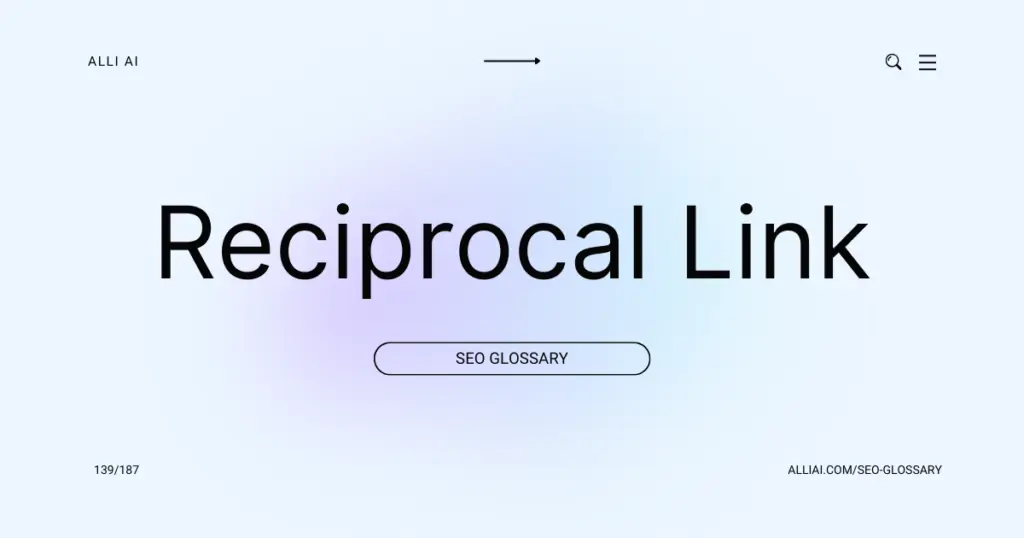What Does Reciprocal Link Mean?
A reciprocal link is when two websites agree to link to each other. This is often done to help boost each other’s visibility and search engine ranking. Think of it as a digital handshake where each website says, “I’ll mention you if you mention me.”
Where Does Reciprocal Link Fit Into The Broader SEO Landscape?
Reciprocal links occur when two websites agree to link to each other, often to mutually enhance their visibility and search engine credibility. Historically, reciprocal linking was a popular tactic to increase a website’s backlink profile and, subsequently, its search engine rankings. However, the SEO landscape has evolved, and search engines like Google now emphasize the quality and relevance of links over sheer quantity. Excessive reciprocal linking, especially if it appears manipulative or is implemented with irrelevant sites, can be flagged by algorithms as a negative ranking factor. Today, reciprocal linking should be used judiciously as part of a broader, more organic link-building strategy focusing on creating valuable content and natural link growth.
Real Life Analogies or Metaphors to Explain Reciprocal Link
Reciprocal linking is like a handshake between two business owners at a networking event. Each acknowledges the other’s presence and agrees to support one another by introducing connections that can benefit both parties. Similarly, in a reciprocal link, two website owners agree to endorse each other by placing a link to the other’s website on their own. Each benefits by potentially gaining more visitors and improving their site’s visibility.
Another way to view reciprocal links is as a barter system in the digital marketplace, where no money changes hands but each trader exchanges goods of equivalent value. In this case, the goods are links; each site offers a link in exchange for receiving one in return, hoping to enhance each other’s credibility and search engine ranking.
How the Reciprocal Link Functions or is Implemented?
1. Identification of Potential Link Partners: Website owners or SEO professionals identify other websites within their niche or industry that have content relevant to their own.
2. Outreach: Contact is made with the owners or webmasters of these potential partner sites, usually through email, to propose a reciprocal link exchange.
3. Agreement: Both parties agree to link to each other’s websites. The terms of where and how the links will be placed are discussed and confirmed.
4. Link Placement: Each website embeds a hyperlink pointing to the other’s website. These links can be placed within various content areas such as blog posts, partners’ pages, or footer links.
5. Verification: Both parties check the links on each other’s sites to confirm they are implemented as agreed.
6. Monitoring and Adjustment: The performance and impact of the reciprocal links are monitored. Adjustments may be made based on factors like changes in strategy, SEO performance, or website updates.
Impact Reciprocal Link has on SEO
Reciprocal links, where two websites link to each other, can have a mixed impact on SEO. Originally, these were beneficial for SEO as they demonstrated mutual endorsement and relevance to search engines. However, as search engines, particularly Google, have become more sophisticated in detecting artificial link-building practices, the value of reciprocal links has diminished. Excessive reciprocal linking, especially when not relevant to the content, is perceived as a manipulative attempt to increase page rank and can lead to penalties or decreased rankings.
From an SEO performance perspective, a few, well-placed reciprocal links from relevant, high-quality sites can still be beneficial, contributing positively to a site’s authority and relevance. However, when used excessively or inorganically, they can harm a website’s credibility and rankings.
For user experience, reciprocal links that are relevant and add value to content can enhance user engagement by providing further reading or additional resources. This can improve the overall user experience, potentially lowering bounce rates and increasing time on site. Conversely, non-relevant reciprocal links can detract from user experience, appearing spammy or leading users to less useful content, which might increase bounce rates and negatively impact SEO.
SEO Best Practices For Reciprocal Link
1. Identify relevant websites in your niche that complement your content.
2. Contact the website owners or managers through their contact form, email, or social media.
3. Suggest a reciprocal link setup where you link to their site and they link back to yours.
4. Agree on the specifics: choose relevant pages and anchor text for the links.
5. Add the link on your website, either on a resource page, within a blog post, or another appropriate area.
6. Verify the reciprocal link on their site once they’ve placed it.
7. Monitor the link for performance and assess traffic changes or SEO improvements.
8. Maintain the relationship with the website owner for future networking opportunities and possible further link exchanges.
Common Mistakes To Avoid
1. Google Penalization for Manipulative Tactics: Engaging excessively in reciprocal linking specifically as a tactic to manipulate search engine rankings can lead to penalization by Google. Avoid creating link schemes that primarily aim to boost search engine rankings.
2. Irrelevance and Poor Quality Links: Linking to sites that are not relevant to your content or are of poor quality can dilute your site’s credibility. Ensure reciprocal links are with websites that are relevant and offer value to your audience.
3. Overemphasis on Quantity over Quality: Focusing on the sheer number of reciprocal links rather than the quality and relevance can harm your SEO performance. Focus on getting fewer, higher-quality links rather than many low-quality ones.
4. Disrupted User Experience: Reciprocal links that are not integrated naturally into content can disrupt the user experience, possibly leading to higher bounce rates. Only include reciprocal links that add value and context for the reader.
5. Neglecting Nofollow Tags: Not using ‘nofollow’ tags when necessary, especially in cases where links do not organically endorse the linked content, can lead to SEO issues. Use ‘nofollow’ tags to signify to search engines that the link should not influence the ranking of the link’s target.
6. Linking to Sites with Bad Reputation: Linking to sites considered spammy or having a bad reputation can negatively affect your own site’s reputation and SEO rankings. Always check the credibility and reputation of the site before engaging in reciprocal linking.
7. Ignoring Anchor Text Diversity: Over-optimizing anchor text with keywords in reciprocal links can look spammy and get penalized by search engines. Make the linking seem natural with diverse anchor texts.
8. Failure to Monitor Linked Content Changes: The content of the site you link to can change, which might affect your site if it turns irrelevant or inappropriate. Regularly review and reassess your reciprocal links to ensure ongoing relevance and appropriateness.
9. Neglecting Local SEO Opportunities: Exclusively focusing on broad or non-local reciprocal links while neglecting local SEO can be a misstep if your business heavily depends on local customers. Engage in local reciprocal linking where appropriate.
10. Not tracking the impact: Not tracking how reciprocal links affect your site performance makes it hard to justify their continued use or modification. Use analytics tools to monitor the traffic and ranking changes associated with your reciprocal links.






